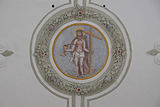Holy Blood (Einsbach)
The Catholic pilgrimage church Heilig Blut in Einsbach , a district of the municipality of Sulzemoos in the Upper Bavarian district of Dachau , about 40 kilometers northwest of Munich , was probably built in the second half of the 14th or beginning of the 15th century in the Gothic style over a fountain, the water of which was said to have a beneficial effect. Until the secularization in 1803, this fountain was the destination of a much-visited pilgrimage. The church is consecrated to the Holy Blood , another patronage is that of St. Sebastian .
history
According to legend , the church is said to have been built in 1004. Since it is not listed in the Konradinische Matrikel , the list of goods of the Diocese of Freising compiled in 1315/16, it is assumed that the building was much later, not before the middle of the 14th century. The church is first mentioned in writing in a document from the Fürstenfeld monastery from 1430. In the 1670s, the church was rebuilt and refurbished in the Baroque style.
Founding legend
A shepherd from Lauterbach Castle is said to have received communion in the parish church in Einsbach on Easter . He wanted to take the host home with him, but when he stepped over a cattle gate on the outskirts, it is said to have slipped from his hand. A spring is said to have sprung from the place where the host fell on the earth. This was taken and the pilgrimage church was built above it.
architecture
Exterior construction
In the southern corner of the choir, the octagonal bell tower rises above the rectangular substructure, which is crowned by a shingle-covered pointed helmet with a golden pommel . The entire outer wall of the tower is covered with filigree rod and tracery decor . The sacristy , which is covered by a pent roof, adjoins the tower to the west .
inner space
The single nave is divided into three axes and ends in a slightly drawn-in choir , closed on three sides , two steps above the nave. The two-bay choir is covered by a star vault with stitch caps. It is - like the window reveals, the parapet and the arching of the gallery - decorated with rich stucco decoration. On a fresco set in a stucco frame made of pearl rod , Jesus is depicted as the Man of Sorrows with a crown of thorns and a cross, who with a goblet catches the blood that flows from his side. The painting is dated around 1680 and refers to the patronage of the church. The walls of the choir and nave structure fluted pilasters with pieces of cornice and Corinthian capitals with acanthus leaves .
Leaded glass window
The lead glass windows in the choir date from around 1910. St. Joseph is depicted on the left window and Mary on the right window .
Fountain
In front of the choir is a marble-lined draw well with an iron grille. The year 1688 is carved on the marble basin. The well is said to have originated at the place where, according to legend, the Shepherd's Host fell on the ground.
Furnishing
- The choir altar is dated around 1630 and attributed to Constantin Pader . The oil painting on the altarpiece depicting St. Sebastian was done in the early 18th century by Johann Baptist Baader (1717–1780).
- The pulpit made of marbled wood is dated around 1680. The pulpit is decorated with angel putti.
- Next to the staircase to the gallery is an offering box from 1680.
- The choir grille comes from the baroque period.
- The choir stalls from around 1680 were restored and put back in their original location in 2007.
- The pews with their baroque cheeks were made around 1700. They are still provided with the name tags that reserved fixed places in the church for members of a family.
- A figure of the peasant saint Notburga von Rattenberg is placed above the entrance on the north side .
- On the pedestal at the choir arch are a third Anna and Saint Rochus of Montpellier .
- On the wall under the gallery hang votive pictures with the representation of St. Sebastian, which remind of the second patron saint of the church.
Epitaphs
Two marble epitaphs under the gallery commemorate the pastors Simon Widman († 1683) and Urban Widman († 1731).
literature
- Georg Dehio : Handbook of German Art Monuments - Bavaria IV - Munich and Upper Bavaria . 2nd Edition. Deutscher Kunstverlag, Munich 2002, ISBN 3-422-03010-7 , p. 240-241 .
Web links
- Heilig Blut pilgrimage church in Einsbach Churches and chapels in the Dachauer Land (accessed October 18, 2015)
Coordinates: 48 ° 16 ′ 10.7 ″ N , 11 ° 16 ′ 9.3 ″ E












